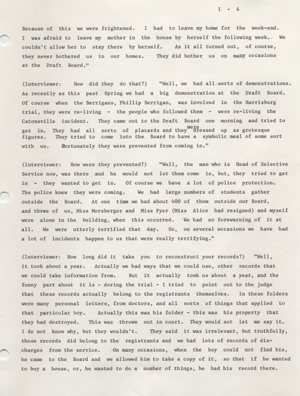 |
Burning of draft board records by Philip and Daniel Berrigan and others, May 17, 1968: an interview with Mary E. Murphy given on November 2, 1972
 |
6 / 15 |
 |



| Collection: |
Friends of Catonsville Library |
| Date: |
1972-11-02 |
| Date of Digitization: |
2004-03-29 |
| Source: |
Catonsville Library |
| Original Dimensions: |
28 x 22 cm |
| Creator: |
Murphy, Mary E. |
|
|
Notes:
This a transcript of a recorded interview with Mrs. Mary E. Murphy who was the Chief Clerk at the Draft Board office no. 33 at the time of the event of the forceful removing and burning of the draft cards by the Catonsville Nine group.
Transcription: Because of this we were frightened. I had to leave my home for the week-end.
I was afraid to leave my mother in the house by herself the following week. We
couldn't allow her to stay there by herself. As it all turned out, of course,
they never bothered us in our homes. They did bother us on many occasions
at the Draft Board."
(Interviewer: How did they do that?) "Well, we had all sorts of demonstrations.
As recently as this past Spring we had a big demonstration at the Draft Board.
Of course when the Berrigans, Phillip Berrigan, was involved in the Harrisburg
trial, they were re-living - the people who followed them - were re-living the
Catonsville incident. They came out to the Draft Board one morning and tried to
get in. They had all sorts of placards and they dressed up as grotesque
figures. They tried to come into the Board to have a symbolic meal of some sort
with us. Fortunately they were prevented from coming in."
(Interviewer: How were they prevented?) "Well, the man who is Head of Selective
Service now, was there and he would not let them come in, but, they tried to get
in - they wanted to get in. Of course we have a lot of police protection.
The police knew they were coming. We had large numbers of students gather
outside the Board. At one time we had about 400 of them outside our Board,
and three of us, Miss Morsberger and Miss Pyer (Miss Alice had resigned) and myself
were alone in the building, when this occurred. We had no forewarning of it at
all. We were utterly terrified that day. So, on several occasions we have had
a lot of incidents happen to us that were really terrifying."
(Interviewer: How long did it take you to reconstruct your records?) "Well,
it took about a year. Actually we had ways that we could use, other records that
we could take information from. But it actually took us about a year, and the
funny part about it is - during the trial - I tried to point out to the judge
that these records actually belong to the registrants themselves. In these folders
were many personal letters, from doctors, and all sorts of things that applied to
that particular boy. Actually this was his folder - this was his property that
they had destroyed. This was thrown out in court. They would not let me say it.
I do not know why, but they wouldn't. They said it was irrelevant, but truthfully,
those records did belong to the registrants and we had lots of records of dis-
charges from the service. On many occasions, when the boy could not find his,
he came to the Board and we allowed him to take a copy of it, so that if he wanted
to buy a house, or, he wanted to do a number of things, he had his record there.
|




